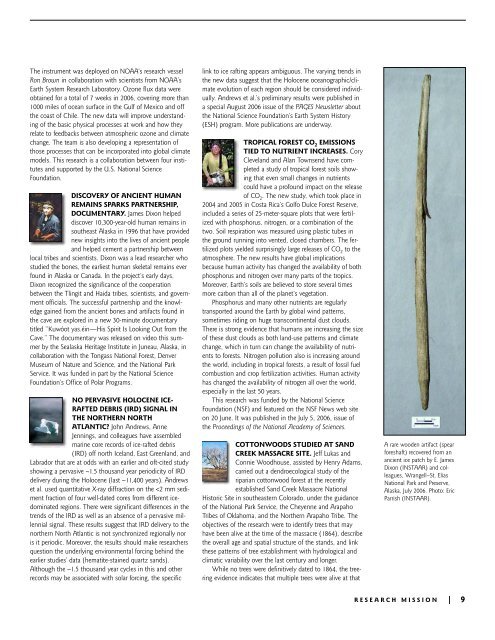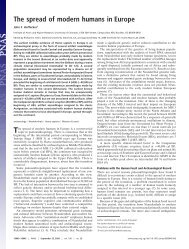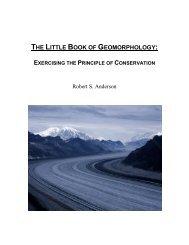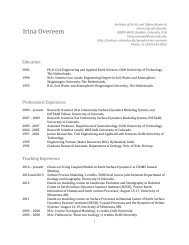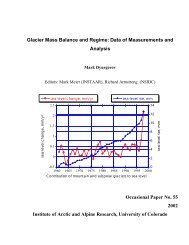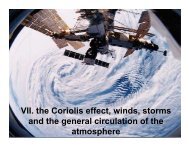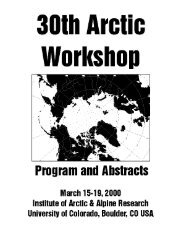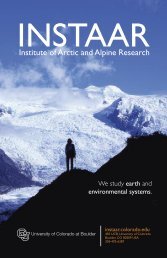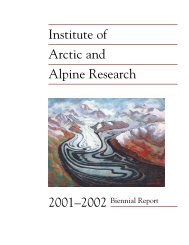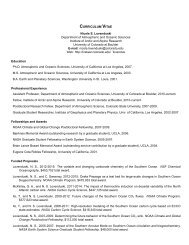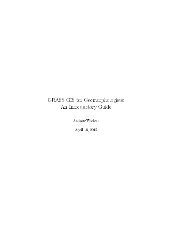Research Spotlights2<strong>00</strong>6GLACIERS ADDING MORE TO GLOBALSEA RISE THAN ICE SHEETS. Tad Pfeffergave a presentation at the national AmericanGeophysical Union (AGU) meeting titled“Disappearing Glacial Ice: a GlobalSynthesis” based on his work with fellow<strong>INSTAAR</strong>s Mark Meier, Mark Dyurgerov,Robert Anderson, Suzanne Anderson, Shad O’Neel, andUrsula Rick. Their study was based on the several hundredthousand small glaciers and small, pancake-shaped icemasses known as ice caps spread around the world in polarand temperate regions. Because <strong>of</strong> the challenge in inventoryingeach individual glacier, the researchers used a mathematical“scaling” process to estimate and characterize moreremote glacier volumes, thicknesses, and trends by factoringin data like altitude, climate, and geography. Their researchshows that small glaciers and ice caps have been contributingmore to rising sea levels in recent years than the largeGreenland and Antarctic ice sheets. In total, the small glaciersand ice caps are shedding about 4<strong>00</strong> billion tons <strong>of</strong> iceyearly—nearly equal to the volume <strong>of</strong> Lake Erie. Earth’s sealevel currently is rising at about 3 millimeters per year andcould rise by several feet or more by the end <strong>of</strong> the centuryif warming on Earth continues, according to recent studies.SKI MOGULS MOVE UPHILL ...REALLY! David Bahr (<strong>INSTAAR</strong> Affiliate)and Tad Pfeffer have used time-lapse photographyto demonstrate that ski mogulsmove uphill, a counter-intuitive result. Theuphill propagating “kinematic waves” arecreated by skiers that scrape <strong>of</strong>f the downhill side <strong>of</strong> onemogul and then pile that snow on the uphill side <strong>of</strong> thenext mogul. The net effect is that each mogul gains materialon top, loses material on the bottom, and thereforemigrates slowly uphill (centimeters a day). Mogul dynamicsresemble other “self-organizing” systems like flocks <strong>of</strong> birdsand LCD crystals. Furthermore, moguls move along ski trailslike electrons on a wire. By treating each trail junction as alogic gate, a fully functional (albeit very slow) computer canbe constructed from moguls. This research may help skiareas better plan how and where to place gates on trails. Skiracers might also benefit from understanding the physics <strong>of</strong>mogul movement. The bumps that the last racer is skiingare compressed toward them compared to the first skier.Bahr and Pfeffer’s research is ongoing at the MaryJane/Winter Park Ski Resort.FIRST SHIP-BORNE MEASUREMENTSOF OZONE FLUXES TO THE OCEAN.Detlev Helmig, Jacques Huber, and other members<strong>of</strong> <strong>INSTAAR</strong>’s Atmospheric Research Labhave worked with colleagues at NOAA andthe Max Planck INstitute in Mainz, Germany,to obtain the first ship-borne direct measurements <strong>of</strong> ozonefluxes to the ocean. Ozone is a greenhouse gas that canwarm the Earth’s climate by absorbing heat energy from theEarth. While scientists have learned a great deal about howozone is created and destroyed in the atmosphere, there arestill many missing pieces <strong>of</strong> the puzzle, especially for theoceans. The research team spent several years developingan ozone + NO chemiluminescence instrument that allowscontinuous ozone flux measurement by the eddy correlationtechnique from a sampling tower on the bow <strong>of</strong> a ship.Jacques Hueber (<strong>INSTAAR</strong>) andLudovic Bariteau (CIRES/NOAAESRL) installing a new ozone fluxinstrument on the NOAA researchvessel Ron Brown for participationin the TEXas Air Quality Study(TEXAQS 2<strong>00</strong>6), Charleston, SC,July 2<strong>00</strong>6. Photo: Jacques Hueber(<strong>INSTAAR</strong>).8 | RESEARCH MISSION
The instrument was deployed on NOAA’s research vesselRon Brown in collaboration with scientists from NOAA’sEarth System Research Laboratory. Ozone flux data wereobtained for a total <strong>of</strong> 7 weeks in 2<strong>00</strong>6, <strong>cover</strong>ing more than1<strong>00</strong>0 miles <strong>of</strong> ocean surface in the Gulf <strong>of</strong> Mexico and <strong>of</strong>fthe coast <strong>of</strong> Chile. The new data will improve understanding<strong>of</strong> the basic physical processes at work and how theyrelate to feedbacks between atmospheric ozone and climatechange. The team is also developing a representation <strong>of</strong>those processes that can be incorporated into global climatemodels. This research is a collaboration between four institutesand supported by the U.S. National ScienceFoundation.DISCOVERY OF ANCIENT HUMANREMAINS SPARKS PARTNERSHIP,DOCUMENTARY. James Dixon helpeddis<strong>cover</strong> 10,3<strong>00</strong>-year-old human remains insoutheast Alaska in 1996 that have providednew insights into the lives <strong>of</strong> ancient peopleand helped cement a partnership betweenlocal tribes and scientists. Dixon was a lead researcher whostudied the bones, the earliest human skeletal remains everfound in Alaska or Canada. In the project’s early days,Dixon recognized the significance <strong>of</strong> the cooperationbetween the Tlingit and Haida tribes, scientists, and government<strong>of</strong>ficials. The successful partnership and the knowledgegained from the ancient bones and artifacts found inthe cave are explored in a new 30-minute documentarytitled “Kuwóot yas.éin—His Spirit Is Looking Out from theCave.” The documentary was released on video this summerby the Sealaska Heritage Institute in Juneau, Alaska, incollaboration with the Tongass National Forest, DenverMuseum <strong>of</strong> Nature and Science, and the National ParkService. It was funded in part by the National ScienceFoundation’s Office <strong>of</strong> Polar Programs.NO PERVASIVE HOLOCENE ICE-RAFTED DEBRIS (IRD) SIGNAL INTHE NORTHERN NORTHATLANTIC? John Andrews, AnneJennings, and colleagues have assembledmarine core records <strong>of</strong> ice-rafted debris(IRD) <strong>of</strong>f north Iceland, East Greenland, andLabrador that are at odds with an earlier and <strong>of</strong>t-cited studyshowing a pervasive ~1.5 thousand year periodicity <strong>of</strong> IRDdelivery during the Holocene (last ~11,4<strong>00</strong> years). Andrewset al. used quantitative X-ray diffraction on the
- Page 1 and 2: INSTAARInstitute of Arctic and Alpi
- Page 3 and 4: BiennialReport2005-2006Institute of
- Page 5 and 6: INSTAAR: An Earth andEnvironmental
- Page 7 and 8: CU-Denver campus where she helped t
- Page 9: Where in the world is INSTAAR? Acti
- Page 13 and 14: altered by humans over the past 200
- Page 15 and 16: ties. However, manmade reservoirs a
- Page 17 and 18: Arctic WorkshopThe annual Arctic Wo
- Page 19 and 20: Wendy Roth (INSTAAR) explains the p
- Page 21 and 22: camera equipment. These laboratorie
- Page 23 and 24: Research Grants: Fiscal Years2004-2
- Page 25 and 26: Ogilvie, Astrid: NSF. HSD: Human an
- Page 27 and 28: Theses Completed2005Breiter, Nehale
- Page 29 and 30: Gifford MillerGEOL 1060, Global Cha
- Page 31 and 32: Lana Cohen, MS, Atmospheric and Oce
- Page 33 and 34: Trevor Popp, PhD, Geological Scienc
- Page 35 and 36: Societal Outreach andInformal Educa
- Page 37 and 38: A group of students from Southern H
- Page 39 and 40: Outreach SpotlightsUNDERGRADUATE ME
- Page 41 and 42: Spotlights: Honors, Awards,and Reco
- Page 43 and 44: TIM SEASTEDT WINS THE 2005PACESETTE
- Page 45 and 46: Structure of hierarchically organiz
- Page 47 and 48: William F. ManleyFellow of INSTAAR.
- Page 49 and 50: Alan R. TownsendFellow and Associat
- Page 51 and 52: GeophysicsEdmund AndrewsChief River
- Page 53 and 54: INSTAAR Visiting Scientists,2005-20
- Page 55 and 56: Chris JarosSupervisor: Diane McKnig
- Page 57 and 58: INSTAAR Noon SeminarsSpring 2005Tad
- Page 59 and 60: Graduate Student TalksSpring 2005Ry
- Page 61 and 62:
Journal and BooksArctic, Antarctic,
- Page 63 and 64:
Publications2005Adams, P. N., Storl
- Page 65 and 66:
“El Nino suppresses Antarctic war
- Page 67 and 68:
European settlement of Lake Eyre, S
- Page 69 and 70:
tion of Baffin Island, Arctic Canad
- Page 71 and 72:
and soil quality for sustainable gr
- Page 73 and 74:
Andrews, J. T., Eberl, D. D., and K
- Page 75 and 76:
Cleveland C. C., Reed S. C., and To
- Page 77 and 78:
and Pierre Y. Julien. Journal of Hy
- Page 79 and 80:
Tributaries to the ColoradoRiver th
- Page 81 and 82:
Rocchi, S., LeMasurier, W. E., and


